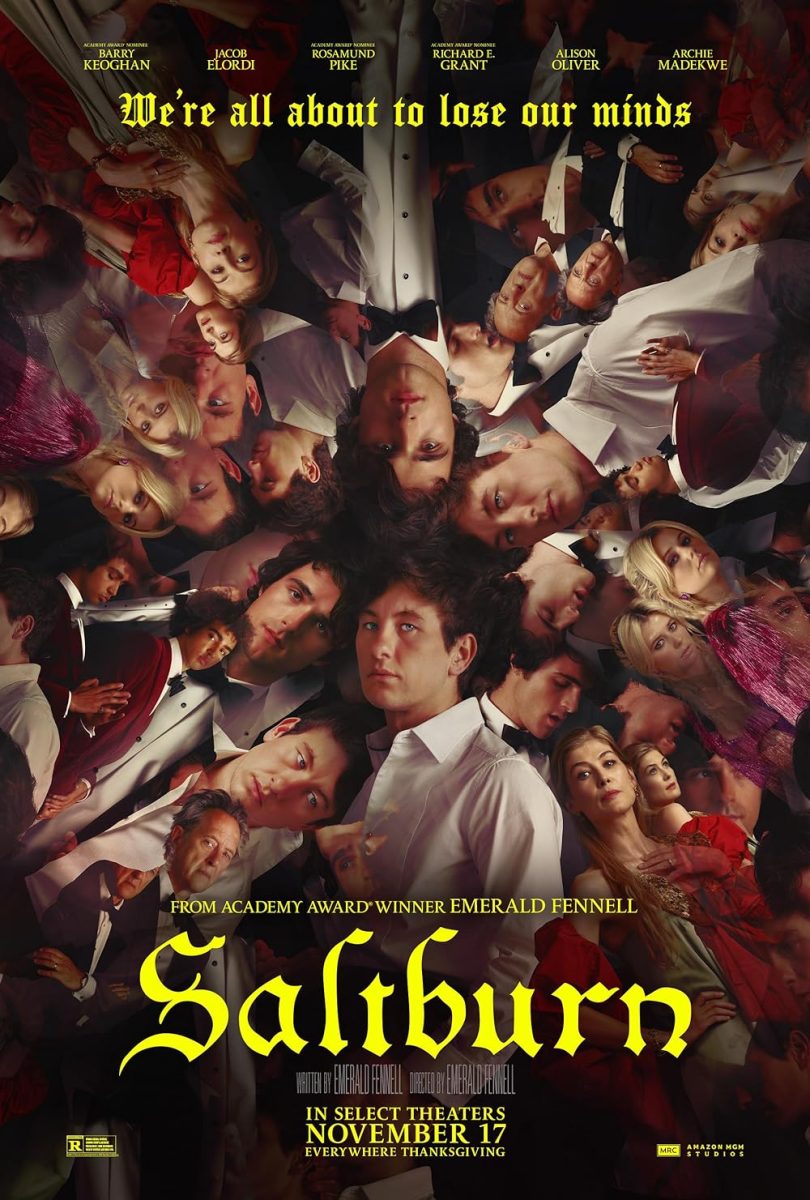“Saltburn” is rated R and contains explicit sexual, violent, and drug/alcohol content.
With its recent rise to popularity through incessant TikToks of people dancing to Ellis-Bextor’s “Murder on the Dancefloor,” clips of Jacob Elordi’s Jimmy Fallon interview where he addresses the infamous bathwater candle, and articles reporting on shocked filmgoers, chances are you are already familiar with Emerald Fennell’s 2023 movie “Saltburn.”
The film follows Oliver Quick (Barry Keoghan), a young, middle-class student who gets a scholarship to attend the prestigious Oxford University. Eager to assimilate with his higher class peers, he befriends the affluent Felix Catton (Jacob Elordi). The two stay at the Catton’s country house (known as “Saltburn”) after Oliver loses his father. From there, lies, deception, and tension grow between the friends until the story takes a gruesome turn.
On the surface, there’s a lot going on in this film. Obsession, class disparity, and envy barely scratch the surface. Along with that, the film features an all-star cast, aesthetically pleasing shots of the Oxford campus, and several provocatively explicit scenes. Suffice to say, the film has garnered a lot of traction, and with that comes a lot of opinions.
The critical reception of the film has consisted of some polarized responses. In the March “Tatler” poll, people praised the film and compared it to works such as “A Clockwork Orange” and “Eyes Wide Shut” (both of which were controversial films in their time), and chastised those who didn’t like the movie, commenting that they went into it expecting a chick-flick or simply just for eye candy. On the other hand, some people expressed the film was pretentious, a rip-off of other works like “The Talented Mr. Ripley,” and that it was trying too hard to be “artsy.” So what is to be made of this? Lucky for you, I risked watching this movie in front of my parents just so I could answer that very question for you.
After watching this film twice, I can confirm that all the people who were gushing about the cinematography of this movie weren’t exaggerating. The film utilizes its set through a neo-gothic aesthetic, which is present in both the framing and symbolism. As cinematographer Linus Sandgren said in an interview with Susannah Edelbaum, “We were attracted by baroque painters like Caravaggio. They have that dynamic light coming through the windows. So we thought of creating expressive imagery where the house was also this object that hides secrets.” This element is particularly noticeable in a scene where light is filtered through red curtains as if covering the screen in blood.
But although the film looks beautiful, it fails to deliver a solid message. The majority of topics raised were only mentioned in a couple spare lines of dialogue, and none of them were fully developed. For instance, there is a scene where Farleigh, a biracial relative of the wealthy Felix’s, confronts Oliver on how he was able to gain the affections of the family so easily. However, Oliver deflects his concerns without an afterthought. That one conversation is the only time where race discrimination in the upper class is directly referenced.
For a film that markets itself as being a class satire, showing random scenes of the upper class enjoying their extravagant lifestyle while only making surface-level comments criticizing said lifestyle misses the mark. By the time the credits rolled, I was left with a jumble of half-baked ideas. After deliberating about the issue for a while, I came to the following conclusion: The movie relies on its own aesthetics to provide themes or commentary when the style should be acting in service of the film’s message.
Because “Saltburn” lacks direct discussion of its themes, viewers are left to tie the pieces together from the subtext within the non-verbal aspects of the movie: the symbolism and cinematography. On one hand, some people believe Oliver’s Minotaur costume to be symbolic of the maze his character is trapped in throughout the film as he gets more entangled in Felix’s lifestyle. Others think it represents him dragging the naïve Felix (dressed as Icarus) along the maze. Some even completely ignore the Minotaur symbolism and focus only on the Icarus motif.
These interpretations have resulted in a permanent back and forth within viewers who are trying to give it meaning based on the film’s context, all of which bring up possible ideas which could’ve been conveyed in the film. While it is true that good symbolism can be interpreted in many different ways, it becomes a problem when it gets too broad. At the end of the day, the symbolism needs to affirm topics or plotlines that have already been established in the film, whether it be through dialogue or character action.
But since Saltburn has serious theme-commitment issues, people don’t know how to read the subtle subtext of the film. Because of this underdevelopment, the film has too many possible avenues to explore, making it disjointed. To put it simply, “Saltburn” has a case of style over substance.
Beneath the saccharine veneer of its gorgeous cinematography, I’m still not sure what exactly “Saltburn” was trying to say. But the important thing is that we’re all talking about it now. Far more important than the movie’s actual commentary is the meta commentary of how this movie is talked about. This movie is saying something with its casting, setting, and scenes so gratuitous that they infuriate some for their vapidity and compel others to seek that overarching meaning.
There is no denying that director Emerald Fennell made this film to be talked about, whether it’s people scouring for some justification for why the film is a masterpiece or movie purists ordering for it to be salt-burned. Wherever you stand, I think that we can all agree the real satire is that “Saltburn” is the loudest and most divisive movie of the year despite not really saying anything at all.


